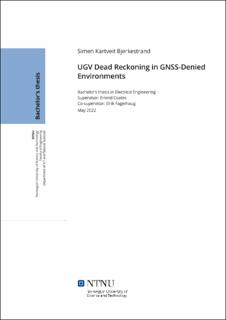| dc.contributor.advisor | Coates, Erlend | |
| dc.contributor.advisor | Fagerhaug, Eirik | |
| dc.contributor.author | Bjerkestrand, Simen Kartveit | |
| dc.date.accessioned | 2022-07-05T17:21:41Z | |
| dc.date.available | 2022-07-05T17:21:41Z | |
| dc.date.issued | 2022 | |
| dc.identifier | no.ntnu:inspera:110437709:110437907 | |
| dc.identifier.uri | https://hdl.handle.net/11250/3002896 | |
| dc.description.abstract | Målet med dette prosjektet er å finne en kombinasjon av sensorer og filtre for å finne ut hvor få sensorer som trengs for dødregning av et Ackerman basert autonomt lasthåndteringskjøretøy. I dette prosjektet ble det utført tester på en simulert mobil robotmodell for å se hvordan hjulodometri og IMU presterte i et dødregningsscenario. Sensorene ble individuelt evaluert basert på når og hvor raskt den estimerte posisjonen drev bort fra den sanne posisjonen. Videre ble anvendelser av sensorfusjon og forskjellige tilstandsestimatfiltre også evaluert. Det ble vist at både hjulodometri og IMU presterte relativt dårlig på egenhånd, og var følsomme for feil i initialisering. Kombinasjonen av hjulodometri og et retningsgyroskop ga den beste lokaliseringen, men har fortsatt rom for forbedring. Hjulodometri og IMU ble også forsøkt, men viste liten eller ingen forbedring i forhold til hjulodometri og retningsgyroskop. | |
| dc.description.abstract | The goal of this project is to find a combination of sensors and filters to find out how few sensors are needed for dead reckoning of an ackerman based autonomous load handling vehicle. In this project, tests were performed on a simulated mobile robot model to see how wheel odometry and IMU performed in a dead reckoning scenario. The sensors were individually evaluated based on when, and how fast the estimated position drifted away from the true position. Furthermore, applications of sensor fusion, and different state estimation filters were also evaluated. It was shown that both wheel odometry, and IMU performed relatively poorly on their own, and were sensitive to errors in initialization. The combination of wheel odometry, and a directional gyroscope provided the best performing localization, but still has room for improvement. Wheel odometry and IMU was also attempted, but showed little to no improvements over wheel odometry and directional gyroscope. | |
| dc.language | eng | |
| dc.publisher | NTNU | |
| dc.title | UGV Dead-reckoning in GNSS Denied Environments | |
| dc.type | Bachelor thesis | |
